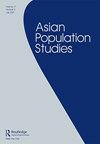Labour market uncertainty and the economic foundations of marriage in South Korea
IF 1.5
4区 社会学
Q2 DEMOGRAPHY
引用次数: 4
Abstract
ABSTRACT Using data from the Korean Labor and Income Panel Study (1998–2014), this study examines how various indicators of socioeconomic status (SES) (i.e. education, employment status, occupation, and earnings) are associated with the transition to first marriage for South Korean men and women. Results from discrete-time event-history analysis show that all SES indicators are strongly associated with the timing of marriage for men and that there is a clear SES gradient for men's marriage entry. In addition, women with high SES (regular, white-collar jobs, and the highest earnings) are more likely to get married than those with lower SES. We also find that securing a regular job is a significant factor for marriage formation regardless of gender. These results indicate that among those with high SES in South Korea, the economic foundations of marriage appear to be characterised by the cooperation model.韩国劳动力市场的不确定性和婚姻的经济基础
摘要:本研究使用韩国劳动和收入小组研究(1998-2014)的数据,研究了社会经济地位(SES)的各种指标(即教育、就业状况、职业和收入)与韩国男性和女性向初婚的过渡之间的关系。离散时间事件历史分析的结果表明,所有社会经济地位指标都与男性的结婚时间密切相关,并且男性的婚姻进入存在明显的社会经济地位梯度。此外,社会经济地位高的女性(定期白领工作,收入最高)比社会经济地位低的女性更有可能结婚。我们还发现,无论性别如何,获得一份稳定的工作都是婚姻形成的重要因素。这些结果表明,在韩国社会经济地位高的人群中,婚姻的经济基础似乎以合作模式为特征。
本文章由计算机程序翻译,如有差异,请以英文原文为准。
求助全文
约1分钟内获得全文
求助全文
来源期刊

Asian Population Studies
DEMOGRAPHY-
CiteScore
3.30
自引率
14.30%
发文量
12
期刊介绍:
The first international population journal to focus exclusively on population issues in Asia, Asian Population Studies publishes original research on matters related to population in this large, complex and rapidly changing region, and welcomes substantive empirical analyses, theoretical works, applied research, and contributions to methodology.
 求助内容:
求助内容: 应助结果提醒方式:
应助结果提醒方式:


